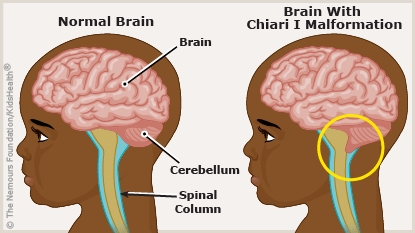Chiari I Malformation
What Is Chiari I Malformation?
Chiari I malformation (key-AR-ee mal-fore-MAY-shun) is when the cerebellum — the part of the brain that controls coordination and muscle movement — pushes down through the hole in the bottom of the skull. This hole is called the foramen (feh-RAY-men) magnum. Usually just the spinal cord passes through the foramen magnum.
Many kids with Chiari I malformation have no symptoms. Treatment can help kids who do have them.

What Are the Signs & Symptoms of Chiari I Malformation?
Some people with Chiari I malformation never have any symptoms. If symptoms do happen, they usually don't show up until late childhood or the teen years.
Signs and symptoms can include:
- headache (especially after sneezing, coughing, or straining)
- balance problems
- neck pain
- dizziness
- vision problems
- poor hand coordination
- numbness and tingling of the hands and feet
- change in bladder (pee) or bowel (poop) habits
- trouble swallowing
- hoarseness
Sometimes, children with Chiari I malformation can also have:
- a syringomyelia (ser-in-go-my-ILL-ee-uh): a fluid-filled space within the spinal cord
- hydrocephalus (hi-droh-SEF-eh-less): a buildup of spinal fluid in the spaces deep within the brain
- sleep apnea: periods when breathing stops during sleep
- scoliosis: curvature of the spine
What Causes Chiari I Malformation?
Chiari malformations happen when the space for the cerebellum is smaller than normal or has an unusual shape. This squeezes part of the cerebellum down through the foramen magnum. If this puts pressure on the cerebellum and spinal cord, it can lead to symptoms.
There are four different types of Chiari malformation (I, II, III, and IV). Chiari I is the most common.
Doctors don't know exactly what causes Chiari I malformation. A baby can be born with Chiari I malformation or it can develop in the first few years of life. Less often, the malformation can happen later in life from trauma, infection, or other medical problems.
Chiari I malformation can run in families. So it may have a genetic cause.
How Is Chiari I Malformation Diagnosed?
Chiari I malformations usually don't cause symptoms. So many aren't found until an imaging study (such as an MRI) of the brain or upper spine is done for a different reason.
How Is a Chiari Malformation Treated?
For kids without symptoms or who have mild symptoms, doctors usually recommend getting follow-up MRIs to check for any changes. Surgery is not usually needed.
For children with severe symptoms, doctors often recommend a surgery called posterior fossa decompression. This surgery makes more space for the cerebellum and lowers pressure on the spinal cord.
Kids with related problems (such as syringomyelia, hydrocephalus, sleep apnea, or scoliosis) may need medical treatment for those conditions.
Some doctors recommend that kids with Chiari I malformation avoid certain activities like gymnastics, wrestling, and contact sports.
How Can Parents Help?
Many kids with Chiari I malformation do not have symptoms and never need treatment. But call your doctor right away if your child does show any symptoms, such as headache, balance or coordination problems, changes in pee or poop habits, or voice changes.
To help your child stay healthy, follow your doctor's instructions for:
- going to all follow-up care visits
- going for all recommended tests, such as X-rays or MRIs
- avoiding any activities, if recommended
Reviewed by: Amy W. Anzilotti, MD
Date Reviewed: Oct 1, 2023
















